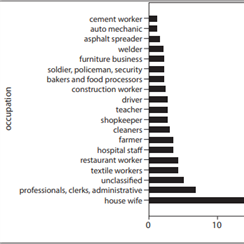OBJECTIVES: It is considered that occupational exposure accounts for up to 25% of all cases of adult asthma. We need detailed individual-level data regarding the relationship between asthma, occupation, and work-related symptoms in Turkey to inform policies on workplace safety. This study aimed to investigate the association between asthma symptoms, occupation type, and workplace exposure in patients with asthma.
MATERIALS AND METHODS: In this cross-sectional multicenter study, adult patients with asthma were investigated by a questionnaire in terms of relationship between asthma symptoms and workplace exposure. The study population was adult patients who had been diagnosed with asthma for at least six months prior to study and who were under follow-up in Ankara, İstanbul, Erzurum, Düzce, Trabzon, Denizli, and Diyarbakır.
RESULTS: The mean age of the 345 cases (188 females) was 41±13 years. The majority of the patients (36.8%) were "housewives”; other common occupations were office workers (6.7%), textile workers (4%), students (3.8%), hospital staff (3.5%), and cleaners (2.9%). Thirty-five percent of patients described worsening of asthma during working periods. Among patients with a history of increased symptoms in workplace, 100 (83%) developed asthma after starting work, while 20 patients (17%) had pre-existing asthma. Half of the patients described workplace exposure to dust, fume, and gases. Exposure to cleaning supplies at home was present in 43% of the subjects. Of all housewives, 12% (n=15) described an increase in their asthma symptoms during housework. The frequency of bleach or hydrochloric acid use alone among housewives was 60% and 34%, which was significantly higher than other occupations. The FEV1/FVC ratio of housewives who frequently used hydrochloric acid (FEV1/FVC=71.5) was lower than that of non-users (FEV1/FVC=74.9) (p=0.024).
CONCLUSION: Patients with asthma experience significant workplace exposures that exacerbate their symptoms. Housewives experience significant exposure that triggers allergic and asthma symptoms. It is important to raise awareness about the prevalence and risks of occupational (including in-home) exposures in asthmatics patients and physicians to minimize asthma triggers and exacerbations.
Cite this article as: Mungan D, Özmen İ, Evyapan F, et al. Work-related symptoms of patients with asthma: A multicenter study. Turk Thorac J 2019; 20(4): 241-7.



.png)

